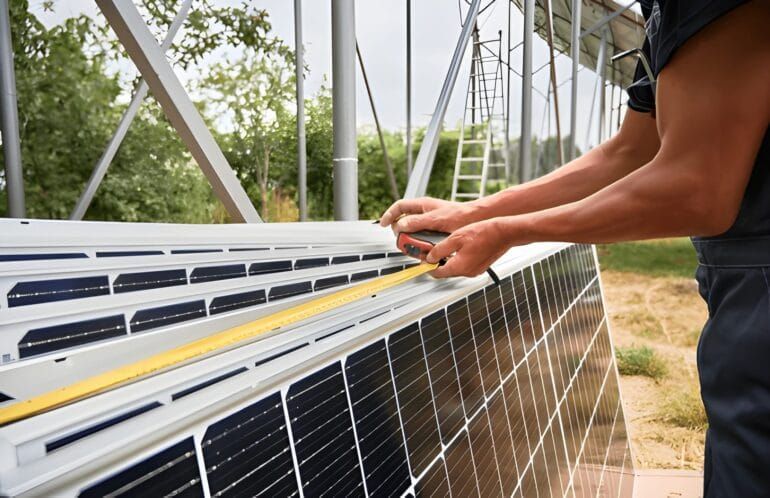Australia’s sunny climate has made it unnecessary to elaborate on the benefits of solar energy. Increased interest in renewable energy creates a need for the best solar panels in the industry, so that one can ensure both efficiency and cost-effectiveness while ensuring sustainability. This guide will explore what the best solar panels are in Australia and help you make an informed choice that stands within your needs and budget.
THE Benefits of Choosing the Right Solar Panels
Selecting the right solar panels can significantly impact the efficiency, longevity, and cost-effectiveness of your solar energy system. High-quality panels ensure better energy production, reduced electricity bills, and long-term savings. Additionally, the right choice can enhance the aesthetic appeal of your home or business, making it a smart investment for both environmental and financial reasons.
Types of Solar Panels
Monocrystalline Panels
Advantages
Monocrystalline solar panels are characterized as having a high efficiency and sleek black profile. The cells are manufactured using a piece of single silicon crystal, which enables them to utilize sunlight into electricity more efficiently compared to other photovoltaic cells. Some key benefits include:
- High Efficiency: Typically ranging from 15% to 20%, making them ideal for limited spaces.
- Longevity: These panels tend to last longer, often exceeding 25 years.
- Aesthetics: Their uniform color and design make them a popular choice for residential rooftops.
Best Uses
Monocrystalline panels are perfect for those homeowners who have tight space for a roof or require super-high efficiency. In fact, they work superbly well in residential as well as commercial applications if there is a bright sunlight exposure.
Polycrystalline Panels
Pros
Polycrystalline panels are those formed from the melting of silicon crystals together. Compared to monocrystalline, they are less efficient, but a bit more economical compared to them. Here’s a close view:
- Efficiency: Typically between 13% and 16%.
- Cost-Effective: Generally cheaper than monocrystalline panels, making them a budget-friendly option.
- Durability: While slightly less efficient, they still offer a good lifespan and are durable.
Cons
They are not as efficient at converting the sun to electricity as monocrystalline panels might be. Such panels may require more space to achieve the same amount of electricity.
Thin-Film Panels
Benefits
Thin-film solar panels consist of one or more thin layers of photovoltaic material applied on a substrate. They are very lightweight, flexible, and easy to install. Here is what you need to know:
- Flexibility: Can be manufactured in various shapes and sizes, making them versatile for different applications.
- Lightweight: Easier to install on surfaces like roofs, walls, and even windows.
- Lower Efficiency: Typically between 10% and 12%, making them less efficient than crystalline panels.
Limitations
They have lower efficiency and a shorter lifespan as compared to the crystalline panel, which does not tend toward high-energy requirements but is perfect for such applications, including BIPV.
What Are the Best Solar Panels in Australia? Explore Now!
LG Solar
Features
LG Solar simply implies innovation and highest performance. Their solar panels are known with forward technology and reliable performance. Generally, among the characteristics include:
- High Efficiency: Models like the LG NeON 2 and NeON R offer efficiencies of up to 21.4%.
- Durability: Built to withstand harsh Australian conditions, with a robust warranty of up to 25 years.
- Aesthetic Design: Sleek, black panels that blend seamlessly with most home designs.
Benefits
LG panels are typically apt for people who need productive, long-lasting, and visually appealing products-that constitute them in residential and commercial installations.
SunPower
Key Features
SunPower is distinguished by Maxeon cell technology, which boasts some of the highest efficiency ratings in the industry. Their panels boast:
- High Efficiency: SunPower panels can achieve efficiencies above 22%, ensuring maximum energy production.
- Long Warranty: Backed by a 25-year warranty, providing peace of mind and long-term performance.
- Robust Design: Designed to withstand harsh weather conditions, ensuring longevity and reliability.
Performance
SunPower panels are best for people who need high efficiency and reliability in areas having less direct sunlight.
REC Group
Advantages
REC Group is fab for high efficiency with sustainability through good quality solar panels. Its REC Alpha Series include:
- High Efficiency: Up to 21.7%, thanks to innovative cell technology.
- Sustainability: REC panels are manufactured with a focus on minimal environmental impact.
- Long Lifespan: Equipped with a 25-year performance warranty, ensuring long-term reliability.
Technology
REC’s use of advanced cell technology and stringent quality control makes their panels a reliable choice for various applications.
Jinko Solar
Innovation
Jinko Solar is one of the largest solar panel manufacturers globally, known for combining quality with affordability. Their Tiger Pro series features:
- High Efficiency: Up to 21.2%, with innovative technology that enhances performance.
- Affordability: Offers excellent value for money, making high-quality solar power accessible.
- Reliability: Backed by extensive testing and certifications, ensuring long-term performance.
Cost-Effectiveness
Jinko panels are a popular choice for both residential and commercial projects due to their balance of performance and cost.

Q CELLS
Performance and Reliability
Q CELLS is known for its high-performance panels, such as the Q.PEAK DUO series. Highlights include:
- Bifacial Technology: The Q.PEAK DUO panels feature bifacial technology, which captures sunlight from both sides, increasing energy yield.
- High Efficiency: With efficiency rates around 20%, these panels deliver strong performance and reliability.
- Robust Warranty: Q CELLS offers long warranties, reflecting their confidence in the panel’s durability.
Factors to Consider When Choosing Solar Panels
The selection of the best solar panel for your needs involves several key factors. Here’s what you should consider:
Efficiency
Solar panel efficiency measures how well a panel converts sunlight into usable electricity. Efficiency is crucial because it determines how much power a panel can generate from a given area. Higher efficiency panels produce more energy, which is especially important if you have limited roof space.
- Efficiency Ratings: Panels typically range from 10% to 22% efficiency. Higher efficiency panels, like those from SunPower and LG Solar, are more effective at converting sunlight into electricity.
- Energy Needs: Consider your household’s energy consumption and how much energy you need the panels to produce. If you have high energy needs or limited space, opting for high-efficiency panels can be beneficial.
Durability and Warranty
The major factors for choosing solar panels include durability and warranty because they ensure long-term functionality and protection.
- Warranty Period: Most reputable brands offer warranties ranging from 10 to 25 years. A longer warranty typically indicates higher confidence in the panel’s durability.
- Weather Resistance: Ensure the panels can withstand local weather conditions, such as heavy rain, high winds, or extreme temperatures. Panels with robust build quality and certifications for weather resistance are preferable.
Cost and ROI
The cost of solar panels can vary significantly based on brand, efficiency, and installation complexity. Here’s how to manage your budget and assess ROI:
- Initial Cost: While high-efficiency panels might have a higher upfront cost, they can lead to greater savings in the long run due to their higher energy production.
- Return on Investment (ROI): Calculate potential savings on electricity bills compared to the cost of the panels and installation. Consider factors like energy production, local electricity rates, and available incentives.
Aesthetics and Design
The design and appearance of solar panels can impact your home’s look. Here’s what to consider:
- Panel Design: Modern panels come in various designs, including sleek, all-black options that blend seamlessly with roofing materials.
- Roof Compatibility: Ensure that the panels you choose are compatible with your roof type and color to maintain your home’s visual appeal.
Installation and Maintenance Tips
Proper installation and maintenance are essential for ensuring the optimal performance and longevity of your solar panels.
Choosing a Reliable Installer
- Experience and Certification: Select a certified and experienced installer with a proven track record. Check for industry certifications and positive customer reviews.
- Quotes and Contracts: Obtain multiple quotes and review contracts carefully. Ensure that the installer offers a detailed plan, including costs, timeline, and warranties.
Maintenance Best Practices
- Regular Cleaning: Keep panels clean to maintain efficiency. Dust and debris can reduce their performance. Clean panels gently with water and a soft brush or cloth.
- Inspection: Periodically inspect panels for any damage or issues. Look for signs of wear, such as cracks or loose wiring, and address any problems promptly.

Government Incentives and Rebates
Australia offers various incentives to make solar panel installations more affordable. Here’s an overview:
Overview of Available Incentives
- Federal Rebates: The Australian government provides the Small-scale Renewable Energy Scheme (SRES), which offers rebates for installing solar panels. The rebate amount depends on the system size and your location.
- State and Territory Programs: Some states and territories offer additional incentives, such as cash rebates or interest-free loans. Check local government websites for specific programs available in your area.
How to Apply for Rebates
- Eligibility Check: Confirm your eligibility for federal and state rebates. Requirements may include system size, installation type, and location.
- Application Process: Complete the application forms provided by the relevant authorities or through your solar installer. Ensure all required documentation is submitted, including proof of purchase and installation details.
Future Trends in Solar Technology
As technology advances, the solar energy industry is experiencing rapid innovation. These future trends are set to revolutionize the way we harness and use solar power.
Innovations on the Horizon
The solar industry is on the brink of several exciting innovations that promise to enhance performance, efficiency, and integration. Here are some key advancements to watch for:
- Bifacial Solar Panels: Bifacial panels can capture sunlight on both sides, increasing their energy yield. This technology improves performance by up to 20% compared to traditional panels, making them ideal for installations with reflective surfaces or in areas with high albedo.
- Perovskite Solar Cells: Perovskite cells are a new type of solar technology that has shown promise in laboratory settings with efficiency rates exceeding 25%. They are cheaper to produce than traditional silicon cells and could significantly lower the cost of solar energy.
- Solar Panel Integration: Future panels are expected to integrate more seamlessly with building materials, such as solar shingles or solar windows. These innovations will allow for aesthetic and functional integration into the architecture of homes and buildings, reducing the need for separate panel installations.
- Flexible Solar Panels: Flexible panels made from materials like organic photovoltaics (OPVs) or thin-film technologies are becoming more advanced. These panels can be used in a variety of applications, from portable solar chargers to flexible solar curtains, expanding the possibilities for solar energy use.
- Enhanced Efficiency Through AI: Artificial Intelligence (AI) is being employed to optimize the performance of solar panels. AI algorithms can predict weather patterns, adjust panel angles, and manage energy output more efficiently, leading to better overall system performance.
Conclusion
Keeping in mind the latest trends and innovations is as important to making the right choices in an increasingly changing solar industry. The future holds increased efficiency, versatility, and reliability from these advanced technologies: not only the bifacial and perovskite panels but also others with energy storage systems. This will improve the efficiency of your solar panels, making them part of a more sustainable and resilient energy system.
FAQs
What is the main advantage of bifacial solar panels?
Bifacial solar panels can capture sunlight on both sides, increasing energy output by up to 20% compared to traditional panels.
How do perovskite solar cells improve on traditional silicon cells?
Perovskite solar cells offer higher efficiency and lower production costs, though they are still being developed for broader commercial use.
What role do energy storage systems play in solar energy?
Energy storage systems, like batteries, store excess solar power for use when the sun isn’t shining, enhancing reliability and enabling greater energy independence.







